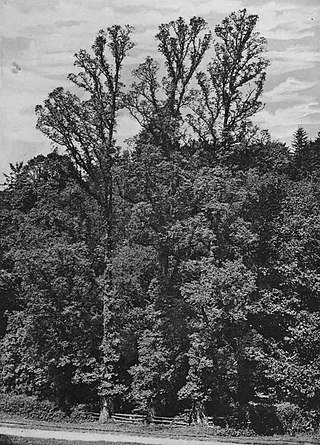
The field elm cultivar Ulmus minor 'Stricta', known as Cornish elm, was commonly found in South West England, Brittany, and south-west Ireland, until the arrival of Dutch elm disease in the late 1960s. The origin of Cornish elm in England remains a matter of contention. It is commonly assumed to have been introduced from Brittany. It is also considered possible that the tree may have survived the ice ages on lands to the south of Cornwall long since lost to the sea. Henry thought it "probably native in the south of Ireland". Dr Max Coleman of Royal Botanic Garden Edinburgh, arguing in his 2002 paper on British elms that there was no clear distinction between species and subspecies, suggested that known or suspected clones of Ulmus minor, once cultivated and named, should be treated as cultivars, preferred the designation U. minor 'Stricta' to Ulmus minor var. stricta. The DNA of 'Stricta' has been investigated and the cultivar is now known to be a clone.

Banksia strictifolia is a species of bushy shrub that is endemic to Western Australia. It has serrated, linear leaves with sharply-pointed teeth on both sides, creamy yellow flowers in heads of between forty-five and eighty-five, and egg-shaped to more or less spherical follicles.

Opuntia stricta is a species of large cactus that is endemic to the subtropical and tropical coastal areas of the Americas, especially around the Caribbean. Common names include erect prickly pear and nopal estricto (Spanish). The first description as Cactus strictus was published in 1803 by Adrian Hardy Haworth. In 1812 he moved the species to the genus Opuntia.

Dampiera stricta commonly known as blue dampiera, is a flowering plant in the family Goodeniaceae. It is a small sub-shrub with variable leaves and mostly blue, mauve or purple flowers.

Nardus is a genus of plants belonging to the grass family, containing the single species Nardus stricta, known as matgrass. It is placed in its own tribe Nardeae within the subfamily Pooideae. The name derives from ancient Greek nardos from the earlier Akkadian lardu. It is not to be confused with spikenard, Nardostachys jatamansi.

Eucalyptus luehmanniana, commonly known as the yellow top mallee ash, is a species of mallee that is endemic to a small area in New South Wales. It has smooth white bark, lance-shaped to curved adult leaves, flower buds in groups of between seven and eleven or more, white flowers and cup-shaped, urn-shaped or barrel-shaped fruit. It has a restricted distribution on poor, rocky soils near Sydney.
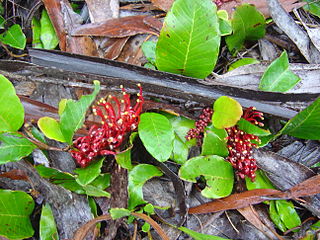
Grevillea laurifolia, commonly known as laurel-leaf grevillea, is a species of flowering plant in the family Proteaceae and is endemic to New South Wales. It is a prostrate, trailing shrub with egg-shaped, heart-shaped or round leaves, and clusters of reddish to deep maroon flowers.

Eucalyptus stricta, commonly known as Blue Mountains mallee ash, is a mallee that is endemic to eastern New South Wales. It has smooth, mottled bark, often with insect scribbles, linear to lance-shaped adult leaves, flower buds in groups of seven, white flowers and urn-shaped to barrel-shaped fruit.

Hibbertia riparia, commonly known as erect guinea-flower, is a species of flowering plant in the family Dilleniaceae and is endemic to the south-eastern Australia. It is an erect to spreading shrub with hairy foliage, linear leaves and yellow flowers with six to sixteen stamens in a single cluster on one side of two carpels.

Hibbertia stricta is a species of flowering plant in the family Dilleniaceae and is endemic to New South Wales. It is a small, usually upright shrub with hairy foliage, linear leaves and yellow flowers with six or seven stamens arranged around two woolly-hairy carpels.
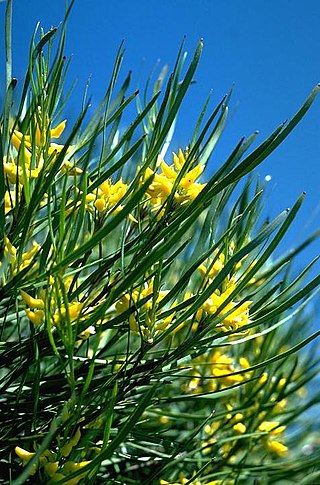
Persoonia stricta is a species of flowering plant in the family Proteaceae and is endemic to the south-west of Western Australia. It is an erect, spreading shrub with smooth bark, linear to spatula-shaped or oblong leaves, and bright yellow flowers borne in groups of four to twenty-five on a rachis 3–100 mm (0.12–3.94 in) long, each flower with a leaf or scale leaf at its base.
Petrophile stricta is a species of flowering plant in the family Proteaceae and is endemic to the south-west of Western Australia. It is an erect, spreading shrub with needle-shaped, sharply-pointed leaves, and oval heads of hairy, pink to cream-coloured flowers.

Verbena stricta, also known as hoary verbena or hoary vervain, is a small purple wildflower native to a large region of the central United States.

Felicia amoena is a variably hairy, sometimes glandular, biennial or perennial plant, of about 25 cm (10 in) high, that is assigned to the family Asteraceae. It is somewhat woody at its base, roots at the nodes if these contact the soil, and has ascending branches. The leaves are oppositely arranged along the stems at and just above a branching fork, further up the leaves alternate. The flower heads sit individually on up to 12 cm long stalks. They are 2–3 cm in diameter and consist of about twelve to twenty five heavenly blue ray florets that surround many yellow disc florets. Three subspecies have been recognised, that differ in width of the leaves and the involucral bracts, the size of the heads and number of ray florets and in having glandular hairs. These can be found in coastal sands and inland areas in the Western Cape and Eastern Cape provinces of South Africa. Flower heads can be found from June till October.
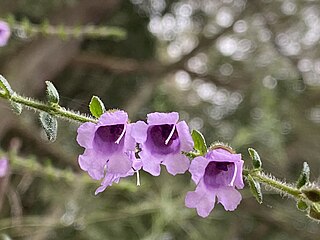
Prostanthera stricta, commonly known as Mount Vincent mint bush, is a species of flowering plant in the family Lamiaceae and is endemic to a small area of New South Wales. It is an bushy, erect, spreading shrub with egg-shaped leaves and mauve flowers with darker spots inside.
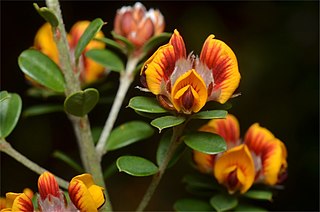
Pultenaea stricta, commonly known as rigid bush-pea, is a species of flowering plant in the family Fabaceae and is endemic to south-eastern continental Australia. It is a slender, erect or low-lying shrub with elliptic to egg-shaped leaves with the narrower end towards the base, and yellow and red, pea-like flowers.
Hibbertia simulans is a species of flowering plant in the family Dilleniaceae and is endemic to New South Wales. It is a much-branched shrub with softly-hairy foliage, linear leaves and yellow flowers with eight to ten stamens on one side of two hairy carpels.

Lobelia browniana is a species of flowering plant in the family Campanulaceae and is endemic to eastern Australia. It is an erect, glabrous, annual plant with narrow leaves and one-sided racemes of blue flowers with long, soft hairs in the centre.
Daviesia stricta is a species of flowering plant in the family Fabaceae and is endemic to inland areas of South Australia. It is an open, glabrous shrub with narrowly-winged branchlets, scattered, narrowly elliptic to linear phyllodes and orange and purplish flowers.

Pimelea stricta, commonly known as gaunt rice-flower, is a species of flowering plant in the family Thymelaeaceae and is endemic to south-eastern continental Australia. It is an erect shrub with narrowly elliptic or linear leaves, and compact heads of densely hairy, creamy-white to yellow flowers surrounded by 4 egg-shaped involucral bracts.

















